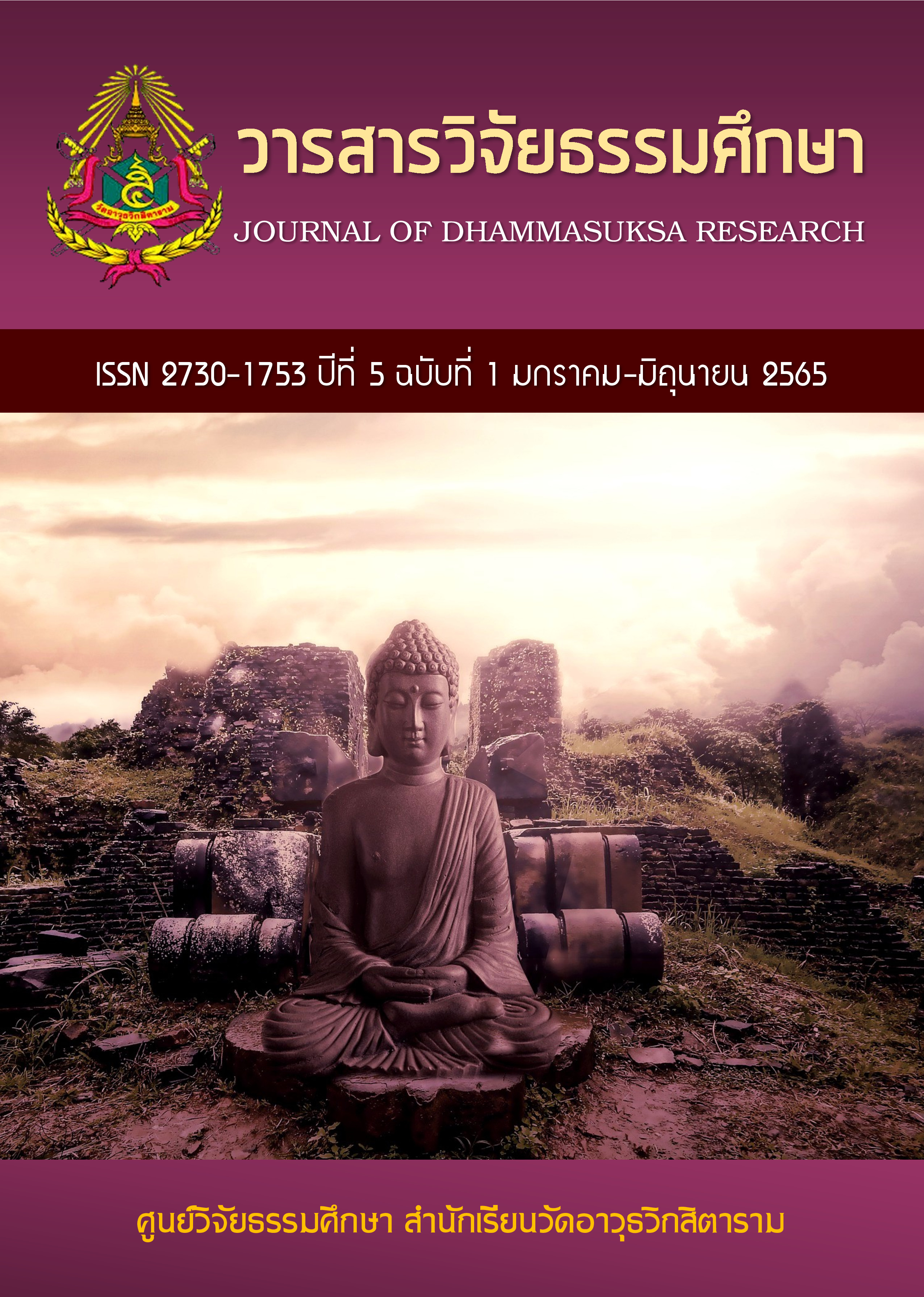Pàǹàtipàta in Five Precepts: Analyzing the Use of Machine and Program to Kill Animals
Keywords:
Pàǹàtipàta, Five Precepts, Killing machine, Killing programAbstract
This article aims to analyze the issue of using slaughtering machines and programs in abattoirs according to the Pàǹàtipàta (killing of animals) in the Five Precepts. There are 2 cases included in the analysis. Firstly, the use of slaughtering machines in the abattoir involves 3 groups of people: 1) the machine designer and manufacturer, 2) the machine purchaser or the abattoir owner, and 3) the workers using the machine. Secondly, the slaughtering program or control of the slaughtering machine in the abattoir involves 3 groups of people: 1) the designer or manufacturer of the slaughtering program, 2) the program purchaser or the abattoir owner, and 3) the workers who control or use the slaughtering program. It was found out that the first group of both cases could be considered the Pàǹàtipàta if they advertise or motivate the abattoir owner to buy the slaughtering machines or program. The second group of both cases is considered to be partaking in the killing by one of the three statuses, namely: the person who commands the others to kill, the person who provides slaughtering tools to the workers, and the person who describes the good side of death or persuades others to partake in the act of killing. The third group of both cases could be considered as partaking in killing by one of the two statuses: the person who uses the machine or program to kill animals and a person who describes the good side of death or persuades others to partake in the act. Based on the Buddhist perspective, there are norms pertaining to the paid work that involves killing as follows: 1) One must abstain from this immoral work, 2) if there is no other choice, the one who partake in the act of killing must be aware that it is immoral to undertake it as work, 3) One who partakes in the act must not do it with the wrong view that it is a moral work, 4) there should be no feelings of joy while practicing one's duty, and 5) if there is an alternative, one should walk away from this work and choose a moral work instead.
References
ปิ่น มุทุกันต์, พันเอก. (2539). แนวสอนธรรมะตามหลักสูตรนักธรรมตรี. พิมพ์ครั้งที่ 2. กรุงเทพฯ: มหามกุฏราชวิทยาลัย.
ปุณวัสส์ กิตติมานนท์. (2554). การศึกษาวิเคราะห์ปาณาติบาตในเซลล์มนุษย์และตัวอ่อนมนุษย์. บรรณาธิการโดย พระมหาสมบูรณ์ วุฒิกโร. กรุงเทพฯ: โรงพิมพ์มหาจุฬาลงกรณราชวิทยาลัย.
พระญาณวโรดม (สนธิ์ กิจฺจกาโร). (2543). เบญจศีล เบญจธรรม และอุโบสถศีล. พิมพ์ครั้งที่ 13. กรุงเทพฯ: มหามกุฏราชวิทยาลัย.
พระพรหมคุณาภรณ์ (ป.อ. ปยุตฺโต). (2557). พุทธธรรมฉบับปรับขยาย. พิมพ์ครั้งที่ 39 (ฉบับข้อมูลคอมพิวเตอร์ ครั้งที่ 8). กรุงเทพฯ: มหาวิทยาลัยมหาจุฬาลงกรณราชวิทยาลัย.
พระมหาสมปอง มุทิโต. (2558). คัมภีร์อภิธานวรรณนา. อุดรธานี: ศูนย์วิปัสสนากรรมฐานวิหารธรรม.
มติชนออนไลน์ (Matichon online). (2561). โรงฆ่าสัตว์ กทม. พลิกโฉมวงการเนื้อไทย. (ออนไลน์)-วันที่ 23 สิงหาคม 2561-เวลา 12:35 น. สืบค้นเมื่อ 4 พฤษภาคม 2564. จาก https://www.matichon.co.th/ local/quality-life/news_1098351.
มหาจุฬาลงกรณราชวิทยาลัย. (2539). พระไตรปิฎกภาษาไทย ฉบับมหาจุฬาลงกรณราชวิทยาลัย. กรุงเทพฯ: โรงพิมพ์มหาจุฬาลงกรณราชวิทยาลัย.
มหามกุฏราชวิทยาลัย. (2536). พระไตรปิฎกและอรรถกถาแปล ฉบับมหากุฏราชวิทยาลัย 91 เล่ม. พิมพ์ครั้งที่ 3. กรุงเทพฯ: โรงพิมพ์มหามกุฏราชวิทยาลัย.
มหามกุฏราชวิทยาลัย. (2550). วินัยวินิจฉัย. พิมพ์ครั้งที่ 13. กรุงเทพฯ: มหามกุฏราชวิทยาลัย.
มหามกุฏราชวิทยาลัย. (2551). อุปกรณ์วินัยมุขเล่ม 1. พิมพ์ครั้งที่ 18. กรุงเทพฯ: มหามกุฏราชวิทยาลัย.
วรรณสิทธิ ไวทยเสวี. (2548). คู่มือการศึกษาพระอภิธัมมัตถสังคหะ ปริเฉทที่ 5 วิถีมุตตสังคหวิภาค. พิมพ์ครั้งที่ 6. นครปฐม: มูลนิธิแนบมหาธีรานนท์.
สมเด็จพระญาณสังวร (เจริญ สุวฑฺฒโน). (2542). หลักพระพุทธศาสนา. พิมพ์ครั้งที่ 10. กาญจนบุรี : สหายพัฒนาการพิมพ์.
สมเด็จพระมหาสมณเจ้า กรมพระยาวชิรญาณวโรรส. (2452). วินัยมุขเล่ม 1 หลักสูตรนักธรรมชั้นตรี. พิมพ์ครั้งที่ 41. กรุงเทพฯ: มหามกุฏราชวิทยาลัย.
สมเด็จพระมหาสมณเจ้า กรมพระยาวชิรญาณวโรรส. (2538). เบญจศีลและเบญจธรรม: หลักสูตรธรรมศึกษาชั้นตรี. พิมพ์ครั้งที่ 15. กรุงเทพฯ: มหามกุฏราชวิทยาลัย.
สมเด็จพระมหาสมณเจ้า กรมพระยาวชิรญาณวโรรส. (2552). วินัยมุขเล่ม 1. พิมพ์ครั้งที่ 40. กรุงเทพฯ: มหามกุฏราชวิทยาลัย.

Downloads
Published
How to Cite
Issue
Section
License

This work is licensed under a Creative Commons Attribution-NonCommercial-NoDerivatives 4.0 International License.

